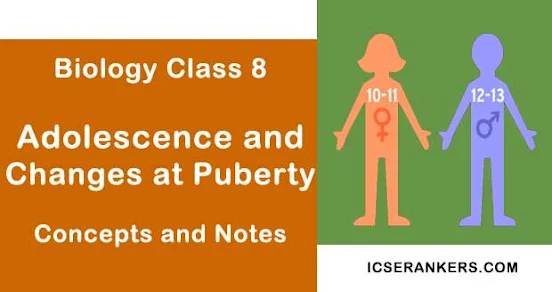Adolescence and Changes at Puberty- Biology Guide for Class 8
Information about Adolescence and Changes at Puberty
Title | Adolescence and Changes at Puberty |
Class | Class 8 |
Subject | Class 8 Biology |
Topics Covered |
|
Living organisms reproduce to increase their number and maintain their species in nature. Most living organisms are able to reproduce only after a certain age in their life cycle.
The life cycle of human beings consists of three main stages of development: childhood, adulthood and old age.
Adolescence
Adolescence is a transitional stage that occurs between childhood and adulthood; this is a stage of physical and mental human development. The term 'adolescence' is derived from a Latin word adolescere which means 'to grow into maturity'.
It is the time of rapid development of growing towards sexual maturity, discovering more about one's self and recognising and defining personal values. An adolescent is neither a child nor an adult; it is the period from about 12 to 18 years of age of a human being.
- During the initial phase of adolescence, there are changes in the body. The adolescents become aware of the physical changes they are going through.
- This 'phase' is between 12 to 15 years of age and is the early adolescent period. These changes mark the onset of puberty.
Puberty
Puberty lasts several years during which rapid physical growth and some psychological changes occur; these lead to sexual maturity This means that the individual becomes capable of reproduction.
- The word puberty, is derived from a Latin word pubertas which means 'age of manhood'.
- The average 'onset of puberty' is at around 10 years of age for girls and 12 years for boys.
- Every person's individual 'time table for puberty' is influenced primarily by heredity; in addition, environmental factors, such as diet and exercise, also have quite some influence.
Changes at Puberty
During puberty the following changes occur:
1. Increase in height
- The onset of the puberty period usually results in a dramatic, sudden and visible increase in height and weight.
- Also, there are changes in the body proportions. The arms and legs grow faster than the rest of the body. This often results in disproportionate size causing awkwardness among adolescents. However, this awkwardness disappears once full growth has been attained.
- This spurt in physical growth is more evident in girls between 11-13 years of age; it is between 13-15 years for boys.
2. Changes in the size of heart and lungs
- There are changes in the size of heart and lungs; these are less apparent but equally important.
- The diameter of the heart increases by about 50% and the weight almost doubles itself.
- There is an increase in the size and capacity of lungs too.
3. Change in body shape
Many changes take place in the shape and size of the body; these changes are different for boys and girls.
4. Change in voice
- Larynx, also known as the voice box, is present in the throat.
- It is a tube-shaped piece of cartilage.
- The larynx is what gives a characteristic pitch of voice to every individual.
- Before puberty, the larynx is small and vocal cords are short and thin; hence, the voice of a child is high pitched than that of an adult.
- As one goes through puberty, the larynx becomes bigger and the vocal cords lengthen and thicken. This makes the voice 'deeper'. This process lasts over a few months. Once the larynx grows fully, the changes in voice stabilise.
- When the larynx grows larger during puberty, it protrudes out in front of the throat. This is called Adam's apple.
- Larynx grows more in boys than in girls; this results in the 'highlighting' of the Adam's apple in front of their necks.
5. Increased acitivity of sweat and sebaceous glands
- The sweat glands of the body develop fully during puberty and there is an increased secretion of sweat.
- Acne and pimples are common among adolescents due to increased production of sebum from the sebaceous glands.
What makes the voice?
When you speak, air rushes from your lungs and makes your vocal cords vibrate; this produces the sound of your voice. The males have longer vocal cords while females have shorter vocal cords. Hence, there is a difference in pitch. The sound changes into speech with the help of teeth, lips and nasal cavity.





